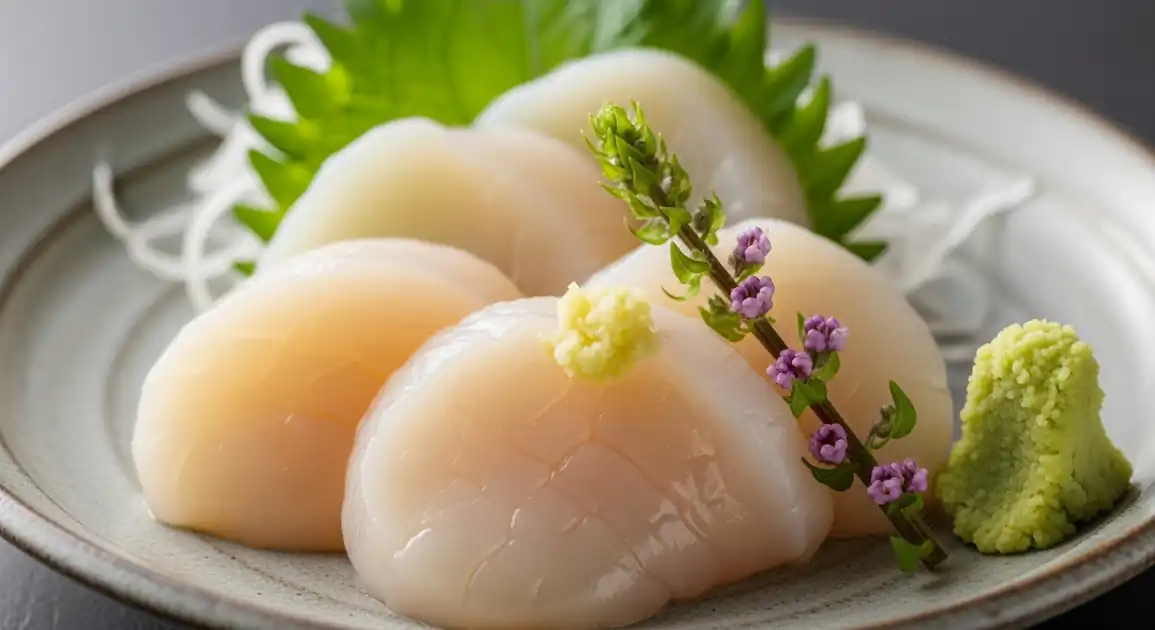Hotate (Scallops)
帆立 (Hotate)

Description
Sapporo, the capital of Hokkaido, is arguably one of the best places in Japan to enjoy exceptionally fresh and delicious Hotate. Sourced directly from Hokkaido's rich waters, scallops here are known for their impressive size and sweetness. Find them prominently featured in seafood markets, sushi bars, izakayas, and restaurants throughout the city.
Dietary Information
Serving information
Serving style
Sashimi, sushi, grilled (shioyaki or butter shoyu), Hotate-don (scallop rice bowl), Hotate Ramen toppings, Hotate Furai. Served with standard condiments like soy sauce, wasabi, sometimes butter or lemon.
Quick facts
Markets: Roughly 7/8 AM - 3/4 PM. Restaurants/Izakayas: Lunch (11 AM - 3 PM), Dinner (5 PM - 11 PM or later).
Safety Tips
What to Look For
-
Reputable source (sushi restaurant, established market vendor, quality restaurant)
Essential for raw consumption. Reputable places adhere to strict hygiene and freshness standards.
-
Fresh appearance (plump, translucent/creamy white, firm)
Visual cues are key indicators of freshness for raw scallops. Avoid dull, discolored, or limp scallops.
-
Clean, sweet smell (slightly briny)
Fresh scallops should smell pleasant. Any off-putting odor (ammonia, strong fishiness) is a major red flag.
-
Proper refrigeration / Cooked to order
Raw scallops must be kept consistently cold. Cooked scallops should be prepared fresh upon ordering.
-
Clean handling practices by staff/vendors
Observe how seafood is handled, looking for clean surfaces, utensils, and handwashing/glove use.
What to avoid
-
Strong fishy, sour, or ammonia-like odor
Indicates spoilage. Do not consume.
-
Dull, discolored (greyish/yellowish), or slimy appearance
Signs that the scallop is not fresh and potentially unsafe, especially for raw consumption.
-
Scallops stored at improper temperatures (e.g., sitting out unrefrigerated)
Increases risk of bacterial growth significantly.
-
Unreputable or dubious sources (e.g., questionable street stalls with poor hygiene)
Higher risk of consuming improperly handled or unfresh seafood.
-
Pre-cut sashimi sitting uncovered for extended periods
Increases exposure to contamination and temperature fluctuations.
Price information
Price range
Budget tips
- Nijo Market and Sapporo Curb Market offer competitive prices for fresh/grilled Hotate compared to some high-end restaurants.
- Look for lunch sets in restaurants which might include Hotate sushi or sashimi.
- Single grilled Hotate at markets can be an affordable snack (400-800 JPY).
Value indicators
- Labelled as 'Hokkaido-san' (北海道産).
- Exceptionally large and plump size.
- Visibly fresh and glistening (if raw).
- Served at dedicated seafood restaurants or popular market stalls.
Where to Find This Dish
Nijo Market (Nijō Ichiba)
Sapporo's famous central seafood market. Numerous stalls sell fresh Hotate (raw/live) and offer grilled Hotate to eat immediately.
Market entrance, Various seafood stalls
Morning (8 AM - 1 PM)
Sapporo Curb Market (Jōgai Ichiba)
Larger wholesale/retail market near the central wholesale market. Many restaurants and stalls serving fresh seafood including Hotate.
Market complex, Adjacent restaurants
Morning to early Afternoon (7 AM - 3 PM)
Susukino
Sapporo's entertainment district, packed with sushi restaurants, izakayas, and seafood specialty restaurants serving Hotate.
Susukino crossing, Various restaurants/izakayas
Evening (5 PM onwards)
Sapporo Station Area
Numerous restaurants in station buildings (Stellar Place, Daimaru) and surrounding streets offer quality seafood.
JR Sapporo Station, Stellar Place, Daimaru Department Store
Lunch, Dinner
Vendor Tips
- At markets, look for stalls grilling Hotate live; choose one cooking over charcoal for extra flavor.
- Ask market vendors 'ima shun desu ka?' (Is it in season now?) to gauge peak quality times.
- In restaurants, 'Hokkaido Jikasei' (Hokkaido homemade/direct source) might indicate special pride or sourcing.
- Don't be afraid to try different preparations – raw, grilled, fried – to appreciate Hotate's versatility.
How to Order
Regional Variations
-
Hotate Ramen
(帆立ラーメン)
Some Sapporo ramen shops offer ramen topped with whole scallops or scallop broth infusion.
-
Hotate-don
(帆立丼)
A rice bowl specifically topped with generous amounts of Hotate sashimi or sometimes cooked Hotate.
-
Local Grilled Flavors
(地元の焼き風味)
Unique local miso or sauce variations for grilled Hotate might be found in specific izakayas.
Cultural context
History
Scallops have been consumed in Japan for centuries. Hokkaido, with its cold, nutrient-rich waters, became the epicenter for high-quality Hotate, both wild-caught and through advanced aquaculture techniques developed significantly in the 20th century. Hotate farming, especially suspension culture, allows for sustainable production of large, high-quality scallops, making them a widely available yet highly regarded seafood item across Japan and internationally.
Local significance
Hotate is a symbol of Hokkaido's rich seafood bounty and a source of local pride. It's a must-try for visitors to Sapporo seeking authentic regional flavors.
Eating customs
- Enjoyed with local Hokkaido sake or Sapporo beer.
- Emphasis on appreciating the natural sweetness, especially when eaten raw.